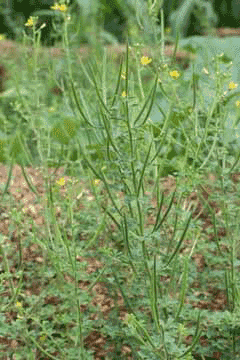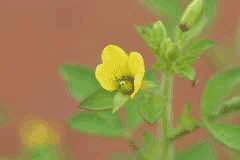 |
|
http://fr.wikipedia.org/wiki/Projet:Botanique/Accord_Henry_Brisse |
 |
| http://fr.wikipedia.org/wiki/Projet:Botanique/Accord_Henry_Brisse |
Translate this page:
Summary
Physical Characteristics

 Cleome viscosa is a ANNUAL growing to 1.5 m (5ft).
Cleome viscosa is a ANNUAL growing to 1.5 m (5ft).
It is frost tender. The species is hermaphrodite (has both male and female organs).
Suitable for: light (sandy) and medium (loamy) soils and prefers well-drained soil. Suitable pH: mildly acid, neutral and basic (mildly alkaline) soils. It cannot grow in the shade. It prefers dry or moist soil.
UK Hardiness Map
US Hardiness Map
Synonyms
Plant Habitats
Cultivated Beds;
Edible Uses
Edible Parts: Leaves Oil Shoots
Edible Uses: Condiment Oil
Leaves and young shoots - cooked as a vegetable[272]. A sharp mustard-like flavour[183]. The pungent seed can be pickled or used as a mustard substitute in curries[183, 272]. The seedpods are made into pickles[183]. The juice of the plant is used as a condiment[183]. An oil obtained from the seeds is used for cooking[272].
References More on Edible Uses
Medicinal Uses
Plants For A Future can not take any responsibility for any adverse effects from the use of plants. Always seek advice from a professional before using a plant medicinally.
Anthelmintic Carminative Diaphoretic Rubefacient Stimulant
The leaves are diaphoretic, rubefacient and vesicant[240]. They are used as an external application to wounds and ulcers[240]. The juice of the leaves has been used to relieve earache[240]. The seeds are anthelmintic, carminative, rubefacient, stimulant and vesicant[240, 272]. The seed contains 0.1% viscosic acid and 0.04% viscosin[240]. A paste of the root is applied externally in the treatment of earaches[272].
References More on Medicinal Uses
The Bookshop: Edible Plant Books
Our Latest books on Perennial Plants For Food Forests and Permaculture Gardens in paperback or digital formats.

Edible Tropical Plants
Food Forest Plants for Hotter Conditions: 250+ Plants For Tropical Food Forests & Permaculture Gardens.
More

Edible Temperate Plants
Plants for Your Food Forest: 500 Plants for Temperate Food Forests & Permaculture Gardens.
More

More Books
PFAF have eight books available in paperback and digital formats. Browse the shop for more information.
Shop Now
Other Uses
Oil
None known
Special Uses
References More on Other Uses
Cultivation details
Prefers a light fertile soil in a warm dry sunny position with plenty of room to spread[200]. A frost tender plant, it can be grown as a summer annual in Britain[200].
References Carbon Farming Information and Carbon Sequestration Information
Temperature Converter
Type a value in the Celsius field to convert the value to Fahrenheit:
Fahrenheit:
The PFAF Bookshop
Plants For A Future have a number of books available in paperback and digital form. Book titles include Edible Plants, Edible Perennials, Edible Trees,Edible Shrubs, Woodland Gardening, and Temperate Food Forest Plants. Our new book is Food Forest Plants For Hotter Conditions (Tropical and Sub-Tropical).
Shop Now
Plant Propagation
Seed - surface sow or only lightly cover the seed in spring in a greenhouse[164]. The seed usually germinates in 5 - 14 days at 25°c[164]. When large enough to handle, prick the seedlings out into individual pots and plant them out in late spring. Day time temperatures below 20°c depress germination but a night time fall to 20° is necessary[164].
Other Names
If available other names are mentioned here
Native Range
Coming Soon
Weed Potential
Right plant wrong place. We are currently updating this section.
Please note that a plant may be invasive in one area but may not in your area so it's worth checking.
Conservation Status
IUCN Red List of Threatened Plants Status :

Growth: S = slow M = medium F = fast. Soil: L = light (sandy) M = medium H = heavy (clay). pH: A = acid N = neutral B = basic (alkaline). Shade: F = full shade S = semi-shade N = no shade. Moisture: D = dry M = Moist We = wet Wa = water.
Now available:
Food Forest Plants for Mediterranean Conditions
350+ Perennial Plants For Mediterranean and Drier Food Forests and Permaculture Gardens.
[Paperback and eBook]
This is the third in Plants For A Future's series of plant guides for food forests tailored to
specific climate zones. Following volumes on temperate and tropical ecosystems, this book focuses
on species suited to Mediterranean conditions—regions with hot, dry summers and cool, wet winters,
often facing the added challenge of climate change.
Read More
Expert comment
Author
L.
Botanical References
200
Links / References
For a list of references used on this page please go here
Readers comment
© 2010, Plants For A Future. Plants For A Future is a charitable company limited by guarantee, registered in England and Wales. Charity No. 1057719, Company No. 3204567.